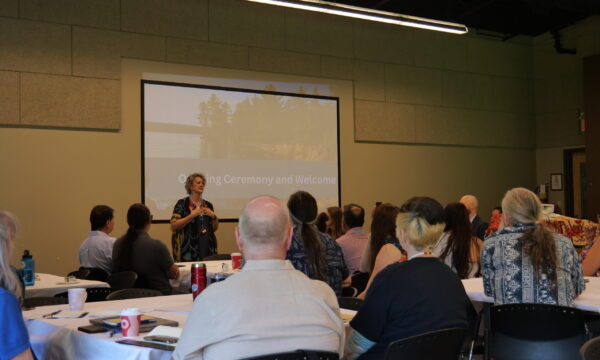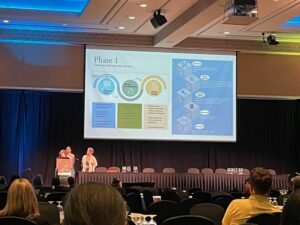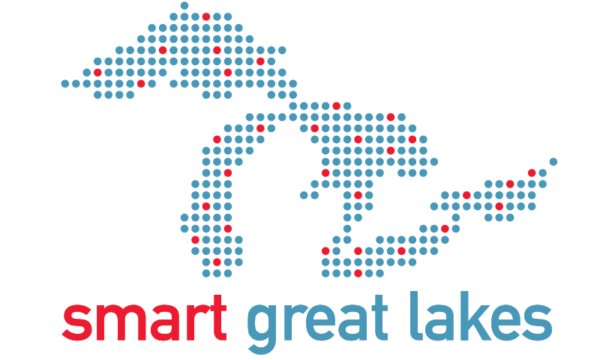
Barbara Wall leads the welcome at the IGLNi gathering at the Ojibway Nature Center, Windsor, Ontario.
The Indigenous Great Lakes Network initiative (IGLNi) held its second in-person meeting on May 24th at the Ojibway Nature Center, in Windsor, Ontario. A few weeks after the meeting, we had the chance to talk with Barbara Wall, of the Indigenous Environmental Institute (IEI) at Trent University, to learn how the second in-person meeting unfolded and to get her perspective on the network’s progress.
The first gathering of the IGLNi took place in October 2023, where over sixty people from 26 Tribes, Nations and Indigenous communities gathered on Chippewas of Rama First Nation territory to discuss community research priorities and the potential of an Indigenous Great Lakes Network. This meeting, however, was preceded by a series of virtual workshops to identify the need and research priorities.
“Even though we were virtual and spread out on both sides of the border, folks were beginning to really connect and build relationships. And they said we need to have an in-person gathering to really get to know each other, to really talk about what our needs are, and maybe where this network idea could go.”
Being member-driven is a key principle of the IGLNi, as Barbara confirmed, “the priorities, the meaning of the network, the activities that the network is going to undertake come from the members.”
May’s meeting took place at the end of the International Association for Great Lakes Research (IAGLR) Conference, thus it attracted some new participants that were already in the area. But it primarily brought many familiar faces from the first gathering: “It was really heartwarming for everybody to see each other again and catch up and not only socialize but then meet with different Great Lakes organizations to talk about research and research obstacles.” Barbara saw that the energy built from the first gathering only accelerated through the second meeting.
“For people to come together and share those commonalities, [it] built a stronger relationship between communities, but it also helped people understand that it’s not just them that are facing challenges… we need a network to be able to support us so that we can address these barriers or obstacles.”
The major difference between the meetings was that, unlike the first meeting being amongst initial network members, May’s meeting introduced outside groups, like the Great Lakes Fishery Commission, Fisheries and Oceans Canada, and the United States Geological Survey (USGS), and others to members. Historically, relationships are tense between Indigenous communities and federal agencies. Yet, Barbara reported that there was a lot of ‘listening’ and, more importantly, ‘hearing’.
“It felt to me that there were new relationships built between network members and the various commissions that may or may not have existed before.”
The meeting seemed to be successful in initiating potential partnerships and opening up necessary dialogues between these groups. Ultimately, Barbara sees this as a long awaited opportunity, facilitated not only by the groups but also by the necessity to protect what is important to all in the region:
“There’s a real mutual desire to start to work together. ‘What can we do on both sides?,’ meaning Indigenous communities and the commissions, what can we do to make this work better because we’re all trying to preserve, protect and enhance the Great Lakes.”
What were some of the priority topics of concern brought up at the meetings?
“A lot of communities have concerns and needs and research priorities around their fisheries. There are many communities that have commercial fisheries. And contamination issues, whether it be land or water or species contamination, came up frequently [during the meeting] all around the Great Lakes.”
One product of May’s meeting was an idea to have the network create an interactive map of the Great Lakes indicating where and how research is being conducted. This would provide basic information for communities to be able to stay up to date and connect with each other over common needs and like research priorities.
“I think what’s happening here, with this initiative and the work between communities and tribes and commissions, is it’s opening the door for deeper understanding, not only of Indigenous issues but Indigenous ways of knowing and Indigenous environmental philosophies and helping research scientists see the bigger picture, to see things from an Indigenous knowledge perspective and a Western science perspective.”
How does the involvement of younger people and students affect the network?
“Grad students and undergrad students have been involved throughout every phase of the project. With the need and the practice to think ahead generationally and knowing that these folks, these young women and men or actually however they identify are going to be the ones that are going to be really implementing things that come out of the network.”

Trent University students and IGLNi members, Jessica Pauze and Caitlin Veri, present on the IGLNi at the International Association for Great Lakes Research (IAGLR) Conference in May.
What is next for the IGLNi?
“Trent University just signed a Memorandum of Understanding (MOU) for a partnership agreement with the Great Lakes Fishery Commission and part of that funding that’s going to come is to support the network with the hiring of a network coordinator to continue to create these valuable workshops for the network members as well as in-person gatherings.”

Barbara Wall…
has been at Trent University for 12 years, five years in a faculty position at the Chanie Wenjack School for Indigenous Studies, after completing her PhD in Indigenous Studies at Trent. She has a varied professional and academic history, having been a geotechnical engineer and a middle school teacher in the San Francisco area, and switched to social sciences to engage in Indigenous Studies. She is from New York State, and an enrolled member of the Citizen Potawatomi Nation of Shawnee, Oklahoma.
Barbara has been a project lead and facilitator for all phases of the IGLNi.
The Indigenous Great Lakes Network initiative (IGLNi) came from a concept designed within the Indigenous Environmental Institute (IEI) at Trent University, identifying the need and desire for diversity in Great Lakes research and policy. The initiative was made possible through a mini-grant through Smart Great Lakes initiative and close collaboration between the GLOS staff, SGLi members, and IEI faculty (Mary-Claire Buell, Chris Furgal and Barbara Wall). Phases for network establishment were designed and put into action. With network operations currently housed in IEI, the goal of the network as a Hub is to be facilitators and a referral system for collaboration between Indigenous communities, researchers, and Great Lakes organizations.
The formal origins of the Indigenous Great Lakes Network initiative began as a part of the Smart Project Series of the Smart Great Lakes Initiative with understanding the need to support respectful engagement and partnership and a strategic approach to knowledge bridging or weaving.
Access the 2022 Smart Great Lakes Initiative Report.
